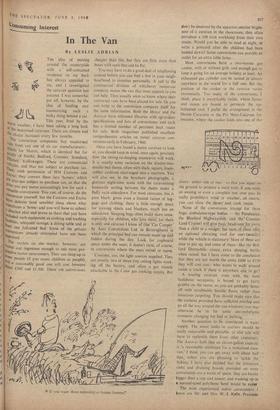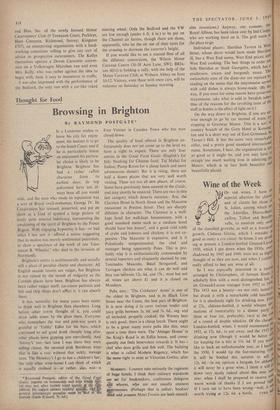In The Van
By LESLIE ADRIAN
THE idea of moving • around the countryside with a self-contained residence on my back has always appealed to me, and I investigated The conversion companies buy unadorned vans from any one of six car manufacturers-- A6stin (or Morris, which is identical but for det4ils 'of finish), Bedford, Comnier, Standard, Thames, Volkswagen. These are commercial vehicles, and thus not subject to purchase tax. Then,with permission of HM Customs and Lkeise, they convert them into 'homes,' which 'ire also •not subject to purchase tax, so that the Price you pay seems astoundingly low for such a versatile conveyance. You can, of course, do the have yourself, but the Customs and. Excise Italie definite (and sensible) ideas about what e°nstitutes a 'home' and you will have to submit 'I detailed plan and prove to them .that you have included such equipment as cooking and washing r aoilities, adequate storage,'a dining table and at 'east one full-sized' bed: Some of the private etNiversions already attempted have not 'been kPproved.. The models on the market, however, are varied and ingenious enough to suit most ,pro- 'Pective motor caravanners. They can sleep. up to s'1411 people (if you count children as people), 4ild -a reasonably good one will cost between 40%1 f:700" and LI,500. There are conversions yon want them meuniere or bonne femme?'
cheaper than this, but they are little more than buses with seats that can lie flat.
You may have to do a good deal of telephoning around before you can find a few in your neigh- bourhood to examine personally. A call to the commercial divisiOn of whichever Motor-car company makes the van that most appeals to you can help. They usually seem to know where their converted vans have been placed for sale. Or you can write to the conversion company itself for the same information. Both the Motor and the Autocar have reference libraries with up-to4late specifications and lists of conversions; and each has a limited number of pertinent back issues for sale. Both magazines published excellent comprehensive articles on motor caravan con- versions early in February, 1960.
Once you have found a motor caravan to look at, you should keep in mind, once again, precisely how the sitting-to-sleeping manoeuvre will work. It is usually some variation on the dinette-into- double-bed theme, often with thick, square, foam- rubber cushions rearranged into a mattress. You will also see, in the brochure photographs, a glorious night-time scene with the caravanning housewife settling between the sheets under a fluffy satin eiderdown. For most caravans, this is pure blurb; given even a limited ration of lug- gage and clothing, there is little enough space, for stowing sheets and blankets, much' less an eiderdtiwn. Sleeping bags often make Moresense, especially for children, who love thetii; for, theie, is only one caraVaii I know of (the 'Car Calliper' by Autii' 'ConversiOns Ltd. in Birmingham) in which the principal bed can remain made up and hidden during the day. Look for cupboard space under the seats; it doesn't exist, of course, in conversions where the seats swivel or move.
Consider, too, the light sources supplied. They are usually two or three tiny ceiling lights work- ing off the battery, and often a gas mantle attachable to the Calor gas cooking supply. But don't be deceivedby the apparent interior bright- ness of a caravan in the showroom; they often introduce a 100 watt worklamp from their own mains. Would you be able to read at night, or write a postcard after the children , had been bedded down? Some conversions can provide an outlet for an extra table lamp.
Most conversions have a two-burner gas cooker, with or without grill. and enough gas to keep it going for an average holiday at least. An exhausted gas cylinder can be turned in' alma' anywhere in the world' for a full one. But the position of the cooker in the caravan varies enormously. Too many of the conversions. I think, place it inextricably inside, where fumes and steam are bound.. to permeate the up- . holstered roof. I prefer the arrangement; in the Devon Caraveue or the Pitt Moto-Caravan. fur instance, w here the cooker folds into.one of the • doors—either side or rear- so that you'Siand on the ground to prepare a meal with if you, wish, an awning or even a complete tent over you. In really prohibitive wind or weather, .-of course, you can close the clpors, and cook inside.
None of the conversions (except for three huge, ambulance-type Wile's— the Patalanian. the Bluebird HighWityhi\A' and Ihet.Commer Land Cruiser), will give basic headroom for more than a child or ,a midget, but most .of,I.hem offer an optional elevating roof for use (usually) while the vehicle. is stationaryi'Most of theSe are easy to put up, and some of theni—like tie Bed- ford Dormobile—creatc, extra sleepipi berths when raised; but I have come to the ..conclusion that they are not worth the extra £100 to £150 they will cost you: who wants "to walk' around inside a truck if there is anywhere. else ,lo go'!
A touring caravan, even with,. the, most fastidious occupants, is bound to get fairly grubby on the move, so you are probably better off 'with scrubhable linotile floors rather .than luxurious carpeting. You should make...sure that the curtains provided. have, sufficient overlap and go all the way around the van windows;.you 'may otherwise be in for some uncontfortable moments changing for bed or bathing..
Another question • to be considered is water supply. The water tanks or carriers should be easily removable and' portable, or else 'you will have to replenish them from other containers. The Amoral• feels that an cleven-gallort, capacity is 'a reasonable minimum for a motorised: cara- van.' I think you can get away with about half that, unless you are planning to 'tackle the Sahara. I have also decided that the miniature sinks and draining hoards provided on some conversions are a waste of space: they are barely bigger than a cup and saucer, and washing up in a normal-sized polythene bowl would be easier.
The most experienced motor caravanners know are Mr. and Mrs. W. J. Kelly. Presideht and Hon. Sec. of the newly formed Motor Caravanners' Club (9 Tennyson Court, Parkleys, Ham Common, Richmond, Surrey; Kingston 8707), an enterprising organisation with a hard- working committee willing to give any sort of advice to prospective caravanners. The Kellys themselves operate a Devon Caravette conver- sion on a Volkswagen Microbus van and even Mrs. Kelly, who was rather against the idea to begin with, finds it easy to manoeuvre in traffic.
I was also impressed with the performance of the Bedford, the only van with a car-like raked steering wheel. Only the Bedford and the VW are low enough (under 6 ft. 6 in.) to be put on the Channel air ferries, though there are those, apparently, who let the air out of their tyres for the crossing to decrease the caravan's height.
If you would like to see a massed fleet of all the different conversions, the Wilson Motor Caravan Centre (36-38 Acre Lane, SW2; BRIx- ton 4011) is holding a rally, with the help of the Motor Caravan Club, at Woburn Abbey on June 10-12. Visitors, even those with mere cars, will be welcome on Saturday or Sunday morning.



































 Previous page
Previous page